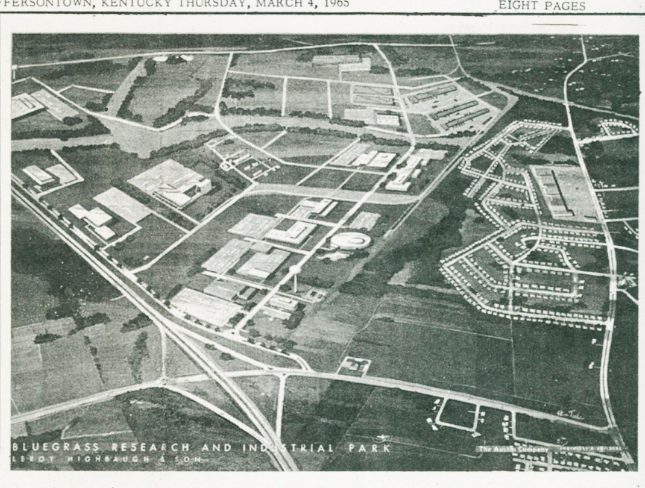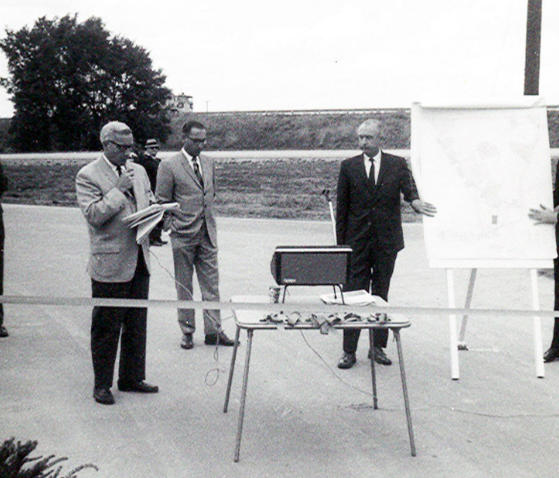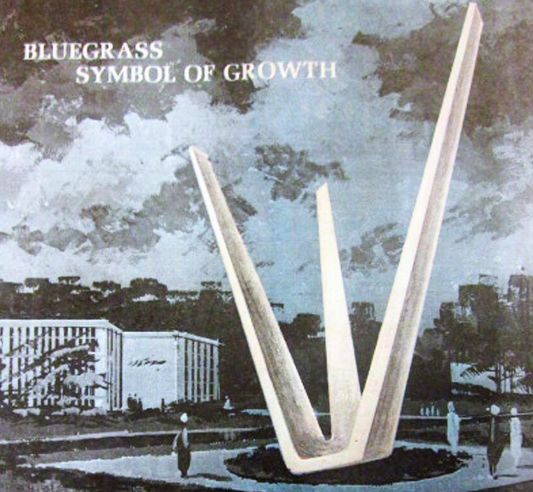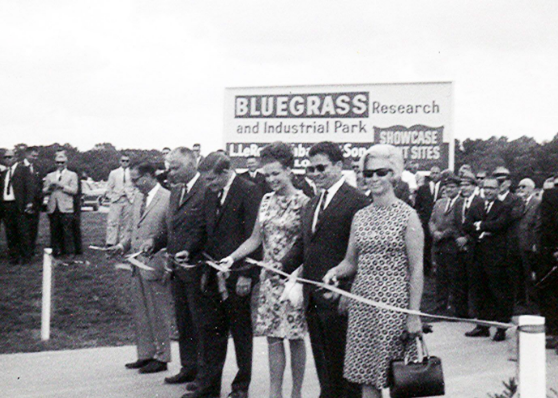Beth Wilder, Director of Jeffersontown Historical Museum
Mention the name Jeffersontown to people, and the first thing they probably associate with it is the Gaslight Festival. The next thing that would likely spring to mind is the Bluegrass Commerce Park, which happens to be the largest industrial park in the state of Kentucky.
 It was the first such development of its kind in the United States – a 600-acre industrial center set amidst park-like surroundings. It now comprises over 1,800 acres and houses over 850 businesses with 38,000 employees. The park’s seven units include Bluegrass Commerce Park, Commonwealth Park, Watterson Trail Industrial Park, Plainview Office Park, Jeffersontown Industrial Park, Holloway Industrial Park, and Blankenbaker Crossings.
It was the first such development of its kind in the United States – a 600-acre industrial center set amidst park-like surroundings. It now comprises over 1,800 acres and houses over 850 businesses with 38,000 employees. The park’s seven units include Bluegrass Commerce Park, Commonwealth Park, Watterson Trail Industrial Park, Plainview Office Park, Jeffersontown Industrial Park, Holloway Industrial Park, and Blankenbaker Crossings.
The park has come a long way from its beginnings over 60 years ago when it was merely a dream in the mind of Jeffersontown real estate broker, Fred Weber. In the late 1950s, Weber was intimately acquainted with the vast amount of farmland all around Jeffersontown, and he envisioned an industrial development taking the place of sprawling corn and wheat fields lying just north of Jeffersontown and south of Interstate 64. He spent seven years getting farmers in the area to agree to sell their land, while he worked on finding a buyer who was willing to pay the asking price.
At first, Southern Railway showed an interest in purchasing the land to resell, but when the potential users backed down, Weber had to try to find another buyer. The Louisville Area Chamber of Commerce was also interested in having the land developed industrially, and they presented the idea to developer L. LeRoy Highbaugh Jr., who bought the 627 acres in 1964 for an average price of $2,600 per acre. The project had the backing of the Jeffersontown City Council and Mayor Franklin J. Chambers, so the land was annexed and zoned for the development that would be called Bluegrass Research and Industrial Park.
 To go along with the park, Highbaugh also intended to develop Bluegrass Estates with 450 lots, and Bluegrass Meadows with 350 lots adjoining the park. From its very inception, the industrial park was a fully-planned endeavor – everyone involved wanted everything related to it to be done right, and that included making sure local residents were fine with the creation of an industrial park. Bill Eadie, sales manager of the park, told the Jeffersontown Chamber of Commerce that the firms he was talking with “don’t want Jeffersontown unless the community wants them.” The Jeffersontown Jaycees even conducted a survey of 1 in 3 homes in Jeffersontown, and it showed that the major thing residents wanted to do was encourage industry. Developers and city leaders were under no illusions as to how long it might take to fill the park with businesses – Eadie says that “It will take 10 years to complete the sales and location operation.” The park would exceed everyone’s hopes, however, as within eight years, the park was nearing 100% development.
To go along with the park, Highbaugh also intended to develop Bluegrass Estates with 450 lots, and Bluegrass Meadows with 350 lots adjoining the park. From its very inception, the industrial park was a fully-planned endeavor – everyone involved wanted everything related to it to be done right, and that included making sure local residents were fine with the creation of an industrial park. Bill Eadie, sales manager of the park, told the Jeffersontown Chamber of Commerce that the firms he was talking with “don’t want Jeffersontown unless the community wants them.” The Jeffersontown Jaycees even conducted a survey of 1 in 3 homes in Jeffersontown, and it showed that the major thing residents wanted to do was encourage industry. Developers and city leaders were under no illusions as to how long it might take to fill the park with businesses – Eadie says that “It will take 10 years to complete the sales and location operation.” The park would exceed everyone’s hopes, however, as within eight years, the park was nearing 100% development.
Before that could occur, however, basic needs had to be met. These included such things as extending sewer facilities to the area and planning entrances to the park that would ease traffic, yet not interfere with residential areas of Jeffersontown. Contracts were signed almost immediately to begin work on water and sewage hook-ups, but egress to the industrial park involved a little more time and cooperation with local residents. Two entrances were created straightaway – one at Hurstbourne Lane, and the other on the part of Watterson Trail that was then known as “Jeffersontown Road.” Developers desperately wished for a road cutting through Merioneth Drive straight back to the park, but residents were adamant that they simply did not want the increased traffic – especially delivery trucks – going through their neighborhood or causing traffic problems at Taylorsville Road so near the railroad overpass. Although the cut-through was brought up repeatedly over the course of several years, the residents won that battle.
 The first major company to announce plans to build in the Bluegrass Research and Industrial Park was Celanese Coating Corporation (a large industrial laboratory), followed by Neptune Meter Company (which made water meters and measures). The H.C. Ackerman and Son Company was the first business to move into its facility in the park, along with Steel Builders Inc., Derby Cone Company, Owen Conrad, Jones Plastic and Engineering Corporation, Reco Sales, and Strohmeier Company, Inc.
The first major company to announce plans to build in the Bluegrass Research and Industrial Park was Celanese Coating Corporation (a large industrial laboratory), followed by Neptune Meter Company (which made water meters and measures). The H.C. Ackerman and Son Company was the first business to move into its facility in the park, along with Steel Builders Inc., Derby Cone Company, Owen Conrad, Jones Plastic and Engineering Corporation, Reco Sales, and Strohmeier Company, Inc.
The park officially held its grand opening Thursday, July 13, 1967, at Bluegrass Parkway and Plantside Drive. Lovely invitations were sent out, bearing the Bluegrass Research and Industrial Park’s three-pronged logo designed to suggest a tuft of bluegrass. An 80-foot high steel version of that logo was to grace the entrance to the park, with the intention of it becoming a landmark in the Louisville area.
The new industrial park helped Jeffersontown receive the designation of an All Kentucky City in both 1968 and 1969, and it was also a leading factor in allowing Jeffersontown to become eligible for its 1969 rise to a city of the 4th class. Jeffersontown did not rest on its laurels, however – the city’s leadership throughout the years has continued to maintain extremely high standards for its industrial park, both in making sure that businesses follow strict codes, and that the needs of both residents and business owners are met by providing such services as upkeep, fire protection, and transportation.
The dream Fred Weber had 60 years ago blossomed into a reality that transformed the town and has kept it prosperous. The City of Jeffersontown has led the way in many innovations that have spread nationwide, and it is because of not only visionaries like Fred Weber, but citizens and city officials alike, who strive to guarantee that Jeffersontown remains at the forefront of the times, while retaining its hometown atmosphere and charm.





